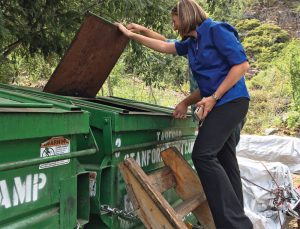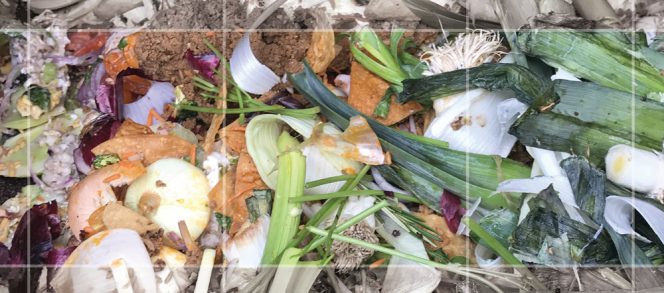The next few years present a paradigm shift in the handling of solid waste, and organic waste in particular, which has real impacts on programs and, consequently, the rates charged to customers.
Carrie Baxter
BioCycle March/April 2019
New California laws, including Assembly Bill (AB) 341 and AB 1826, require businesses and multifamily dwellings with five or more units that generate four or more cubic yards of solid waste per week to receive recycling and organic waste collection service. Beginning in January 2020, AB 1594 will prohibit green material used as alternative daily cover on landfills from qualifying for diversion credit. Senate Bill (SB) 1383 sets the following statewide targets: 50 percent reduction of organic waste sent to landfills from the 2014 level by 2020; 75 percent reduction by 2025; and the recovery of at least 20 percent of all currently disposed edible food for human consumption.
As local jurisdictions and their franchised haulers implement and expand programs to meet these state laws and increase diversion of organics from waste streams, new challenges are emerging. These include how to pay for and enforce participation in the necessary recycling and organics collection services.
Jurisdictions need local mandates that include participation enforcement mechanisms in order to successfully implement effective and sustainable commercial recyclables and organics management systems. Mandates are most commonly being introduced locally through municipal code updates, franchise agreement changes, and detailed rate review adjustments. Program changes in organics collection service, such as rolling it out to every commercial customer, have real costs to haulers, including: increased hauling distance for available processing capacity; increased processing costs as compared to disposal costs; increased contamination of single-use food ware as food scraps collection is increased; additional education and outreach to customers to reduce contamination; and right-sizing collection containers as well as ensuring/maintaining the right fit for enclosures. Charging appropriate customer rates that cover the associated organics management expenses can help provide stability in the revenue base.
New Programs, New Rates
But what exactly is an “appropriate” customer rate? Depending on perspective, the definition may differ. For example, a collection hauler might consider a rate appropriate if it allows the company to develop waste management infrastructure to process recyclable and organic materials while also providing a return on investment. A policy maker might focus on whether customers will receive appropriate levels of service at economical rates that incentivize participation in recycling programs. Finally, customers tend to resist subscribing to a new service that would raise their rates, so their interpretation of appropriate would likely require the additional cost of recycling to be absorbed into their current trash bill.
To dig in deeper on rates, the first step is to look at what goes into a customer’s rate. Typically, a city or county will have arrangements (via franchise agreement or other contract) with one or more solid waste haulers. Solid waste collection services might also be provided by the jurisdiction as a municipal service. At the beginning of an agreement term, or as determined by the jurisdiction’s Municipal Code, a customer’s rate is set. Rates are established based on the total amount of revenue needed to pay for the hauler’s operations in each particular jurisdiction. Customer rates are comprised of the following costs:
• Providing collection
• Processing of organic materials
• Processing and marketing recyclables (final cost is net of recyclable material revenues, if any)
• Final disposition of garbage and residuals in a landfill
• Other fees imposed by a jurisdiction, such as a franchise fee or street sweeping fees
To consider if it is reasonable for a customer rate to incorporate new services, such as the organic materials collection and processing required under SB 1383, California jurisdictions will need to consider how the various provisions in the regulations affect cities and counties, business and residents, solid waste collectors, processors, recyclers, and landfills. Current customer rates may not yet include the direct impacts for new programs that might be implemented, such as expansion of organics processing infrastructure; organics collection and processing; enforcement; education; contamination monitoring; reporting; and capacity planning. In fact, those rates may not even adequately address the costs of providing current recycling services.
To help paint the picture more clearly, specifically in light of the expected regulations under SB 1383 (currently in a public comment period), a recent statewide survey conducted by R3 Consulting Group, Inc. found that in 2018, the specific charge for commercial organics collection services ranged from approximately 30 percent less to as much as double the garbage collection rate. It seems that a new perspective on how to structure rates was offered with each renegotiation of a service agreement and each new proposal to provide service. The correct answer ultimately depends upon the priorities of the local policymakers and what types of ancillary programs might be in place in a particular jurisdiction.

Clear terms and conditions in collection agreements provide the hauler and jurisdiction with a plan to audit for contamination, including visual lid-tipping audits (above). Photo courtesy of R3 Consulting Group, Inc.
R3’s 2018 statewide survey found that in most areas of California, the cost to manage commercial organics is higher than the cost to dispose of that same material. This may be due to the costs of setting up new infrastructure for material processing as well as the stringent permitting and operating requirements for organics facilities (whereas California’s landfills have been permitted and operating for quite some time).
Universal Rate Structure As Solution
A potentially successful strategy might be the roll-out of services to all commercial accounts, with rates that provide a financial incentive to customers to fully participate, combined with a rate adjustment mechanism that makes the haulers financially whole for the additional cost associated with increased diversion. The primary challenge with this approach is that the cost of organics collection would be higher than the garbage collection rate, which financially disincentivizes commercial accounts from actively signing up for organics service. Increased costs for organics collection come from the costs of new infrastructure needs, added step to process the material for recovery prior to disposal, enforcement of state mandated services, and contamination monitoring. For commercial customers to actively participate, a rate structure that adequately compensates haulers for the cost of the associated collection services is needed. This can be accomplished by providing a universal rate structure that provides every customer with a base level of services in a bundled rate that includes the combined cost of garbage, recycling, and organics collection.
Typically, changes to hauler-provided services occur at the start of a new service term. However, policy direction is causing more and more jurisdictions to consider implementing policy changes and ordinance updates before the end of current service terms, in order to include new or revised services. One such potential service option is a universal commercial recyclable and organic materials rate structure. This is already widely used in California for residential collection, where residents are required to pay for minimum (base) garbage, recycling, and organics service levels. Accounts that require higher service levels pay an associated additional fee.
Some examples of successful universal commercial organics rate structures include programs in the cities of Los Altos, Half Moon Bay, and Rolling Hills Estates (see sidebar on Half Moon Bay). Each of these jurisdictions has successfully implemented mandatory commercial and residential recyclable and organic material diversion programs. They incorporate minimum commercial service levels and associated universal rates bundled to cover the cost of garbage, recycling, and organics collection.
The concept of a universal rate structure with a minimum commercial organics service level is intended to:
• Maximize commercial account participation and route efficiencies
• Provide “cost-of-service” sustainable funding for the commercial organics collection system, and the established minimum commercial organics service level
• Provide rates and sustainable funding for organics service levels above the established minimum service level
With new services, such as organics collection, often comes a problem with contamination. Clear terms and conditions in agreements are a great way to provide the hauler and the jurisdiction with an adequate plan to audit for contamination. This can be done through periodic route audits, waste characterization audits, and visual (lid-tipping) audits by the drivers. To effectively manage contamination levels, waste haulers need a way to record high contamination offenders for targeted outreach and/or penalties.
Along with a plan to monitor contamination, customers must be educated about new services. To ensure this happens, haulers often must be given very specific outreach and education requirements. These requirements can be incorporated directly into hauler franchise agreements, although some jurisdictions struggle to attain full hauler participation. In those scenarios, jurisdictions should be prepared to either provide in-house outreach and education, procure separately for such services, or do a combination of both.
Some jurisdictions are ahead of the curve, and have progressively pushed towards diverting more materials from their waste stream. For example, in 2017 the Sonoma County Waste Management Agency released a request for proposals for organic materials processing services to address the countywide need for processing infrastructure. The Agency is currently negotiating a joint agency flow-controlled contract for an organics processing facility that was proposed to be permitted, built, owned, and operated by a contractor in exchange for flow commitments and the profits associated with a set per ton rate for composting organic materials.
On the other hand, some jurisdictions are just now beginning to consider the consequences of procrastinating. For California jurisdictions, these changes are being driven by a state policy direction that leaves them very few options. When considering changes to customer rates to cover associated organics management costs, it is important to understand that the actual cost to provide service typically is minimally related to the container size. Enforcement mechanisms for new policies should include adequate planning for contamination monitoring, outreach and education requirements, and capacity planning through flow control agreements or longer collection agreement term lengths to cover the added costs for new processing equipment and infrastructure needs. These actions to develop a clear path to increase organics diversion can transpire via policies, regulations, negotiations of franchise agreement terms, and public education and outreach.
Carrie Baxter is a Project Manager with R3 Consulting Group, Inc. in Roseville, California. She will be presenting on setting rates for organics collection at BioCycle WEST COAST19 –Track 1, April 2, 2019.















